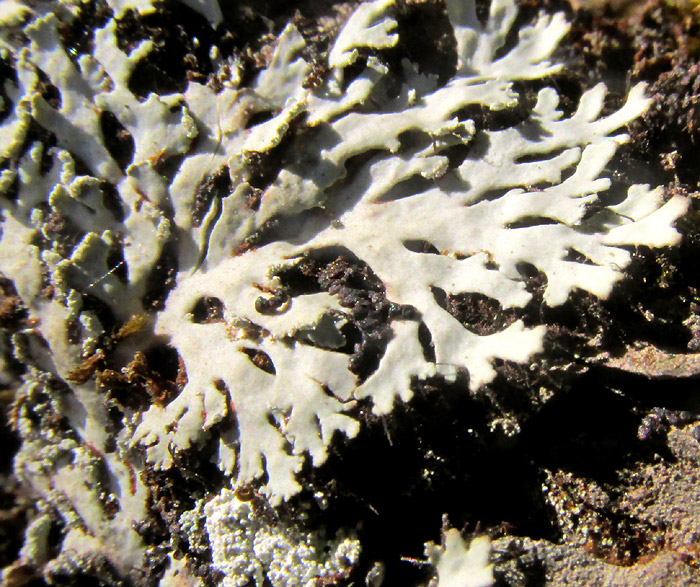Excerpts from Jim Conrad's
Naturalist Newsletter
Entry from field notes dated June 28, 2023, taken in ridgetop forest largely of low-growing Quercus laeta, ridge rising on the southwestern side of Curva de la Doctorcilla, which is near km 18 on the branch road beginning at El Campamento and continuing to El Doctor, and which is numbered Hwy 120, though it branches off the main Hwy 120 running between San Juan del Río and Jalpan; limestone bedrock; elevation ~2930m (~9600 ft), Querétaro, MÉXICO, (N20.85971°, W99.60541°)
SCALY FRINGE LICHEN

Atop the ridge, on bark of a Quercus laeta, the above foliose lichen was unusually small. Even the trees were low growing, probably reflecting the extreme dryness of thin soil atop the ridge's limestone, as well as the exposure to gusty wind gushing across the ridge, and day-long intense sunlight.

Closer up, the slender thalli showed no indication of cup-like apothecia, for sexually producing spores. However, thallus margins and often the upper surfaces themselves often bore tiny, lobe-like to granular appendages. These appendages provided vegetative reproduction. They degenerated into dustlike particles consisting of threadlike fungal hyphae wrapped around cells of algae or cyanobacteria, which when transferred by wind, water or other agencies into an agreeable habitat, can grow into a new lichen. Normally I'd refer to these as isidia, but below we'll see that perhaps the outgrowths are to be referred to as phyllidia. Phyllidia are small, scale-like outgrowths of the lichen thallus surface which usually are attached by a narrow stalk.
In the above picture, notice that not only are these tiny, granular white items produced, but also, toward the center of the picture, and on tree bark on the picture's right side, larger, heaped-up clusters of somewhat spherical, black items occur. Maybe they're caterpillar poop, or maybe they're part of the lichen's vegetative reproductive system. Certain thalli margins appear not only to have white, granular growths but also blackish ones intermediate in size and color with the "caterpillar poop." Below we'll address such surprising appearances. Here's a closer look at the situation.

There you see not only both white and black granular outgrowths, but also even smaller things which are golden in color. Also this is addressed below.

The above thalli were chipped from bark. Notice that thalli tips remain in contact with the bark's surface, and are not loose as with most foliose lichens.
By browsing many Internet images of small, white, foliose lichens, eventually I encountered the genus Heterodermia, comprising about 80 mostly tropical species. Fortunately, in 2009 James. C. Lendemer published his "A synopsis of the lichen genus Heterodermia (Physciaceae, lichenized Ascomycota) in eastern North America." In that publication the identification key seems to lead to, and pictures appear to match, the species HETERODERMIA SQUAMULOSA, sometimes called the Scaly Fringe Lichen.
In Lendemer's paper it's stated that "The asexual propagules of H. squamulosa are remarkably variable marginal phyllidia that frequently disintegrate giving the appearance of coarse soredia or isidia." That's why above I refer to phyllidia and not isidia. Lendemer also says that this species reacts to a K test with a yellow reaction. A K test consists of placing a 10% aqueous solution of KOH, potassium hydroxide, on the surface of a lichen. In certain species a chemical reaction takes place with the lichen's secondary metabolites, and with Heterodermia squamulosa the reaction produces a yellow reaction.
Possibly that explains the golden-colored features noted above. As Wikipedia's Spot Test page explains, other high pH, or caustic, reagents than KOH can be used for spot tests, including household bleach. Dust derived from limestone gravel such as that from the nearby road, combined with cloud-mist water which frequently enshrouds this ridge, could form a lime solution; A saturated solution of lime has a pH of about 12.4.
Lindemer further writes that during his studies of Heterodermia squamulosa he never saw an apothecium, which coincides with our lichen's lack of them.
In eastern North America, Heterodermia squamulosa occurs mainly on hardwood tree bark in the central and southern Appalachian Mountains. Our oak tree atop of ridge often enshrouded in cloud-mist seems similar to that environment. Also, the species has been collected and identified, in 1996, by T.H. Nash III, a much respected lichenologist, in an oak forest at 2880m (we're at elevation ~2930m) in the neighboring state of Hidalgo, in El Chico National Park.
Without a microscope and chemicals for various tests, in this part of the world it's always iffy to identify lichens just from pictures. In this case, it's especially a matter of gathering all the supporting evidence you can, and making the best bet.